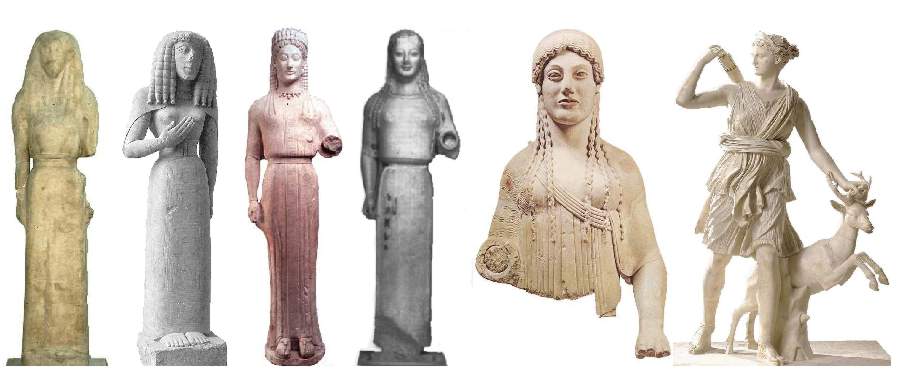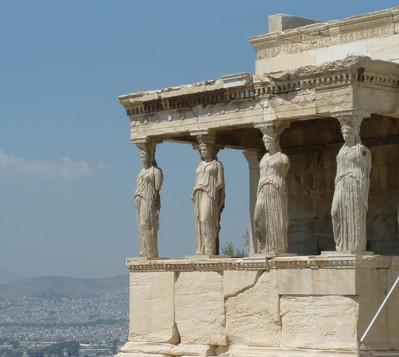QUESTION: How are Egyptian, Greek and Roman art and architecture both interconnected and yet independent and; How did they collectively or independently affect the development of art in the Early Christian period?
 |
| Picture and cite source :"http://www.mlahanas.de/Greeks/Arts/Evolution.htm" |
Answer; Part One- *Summary:During my research, I became more familiar with the styles of art and their significant changes during each time period in the classical era.I had to look a little deeper as to what the common goals were in the creation of these pieces of art and architecture,helping me understand and find a bit of direction in my writing.
*Reason:I realized that the reason this question was asked was to stretch our perspective,and also to help us always find the important connections in the past.
*Direction:To find my conclusions, I started from the (almost) beginning in ancient Egypt, and followed the fundamentals through Greece and Rome. With this insight and knowledge, I could connect ideas for the essay while researching and viewing early Christian artwork. Everything in Art History seems to come full circle.
*Impressions: I was extremely impressed with Greco- Roman art first and foremost.My last essay was clear enough about how much I appreciate the Ancient Egyptian artwork. The development of realism is so profound and beautiful , i was just about in love with so many pieces from Greece and Rome. Not to mention the landscape is so breathtaking that you wouldnt know and couldnt care if the Erechtheion was made of popsicle sticks. (Of course I care!) A funny moment that occured was when I got this Cake song stuck in my head that goes "Sheep go to heaven,Goats go to hell" for the chorus. Laugh it up, and onward we go with the essay!
 |
| "Evolution from the Kouroi(600 BC) to the Hellenistic Apollo Belvedere(320 BC) Evolution/Developmet of realism: 1)c. 600 BC, 2) c.575-550 BC 3)c.560 BC, 4)c. 530-520 BC, 5)c.515-500 BC, 6)c. 485 BC, 7)c.320 BC" Picture and cite source :"http://www.mlahanas.de/Greeks/Arts/Evolution.htm" Part 2- |
"Art is long, and time is fleeting."
I believe this to be so true. Art of any medium and style has origins dating as far back as prehistory. Time seems to go so fast and it's like Art history keeps repeating itself, sometimes even back to the cave period.Once people began to settle down rather than migrate with their food source, civilization is born. We used the earth,our true home, to build basic shelter. Then we wanted to make it pretty too! Symbols were the first universal way of communicating ideas. Humans shaped belief systems,and created beautiful places of worship to appease their gods. Now art ties in by means of the adornment of houses and sacred buildings,which reaches beyond the basic necessity for shelter. The spiritual ties that connect us to the earth make us want to leave beautiful reminders of our legacy here. The devotion to a higher power was a constant motivation for the Egyptians,Greeks,and a little less for the Romans. This of course, carried on into early christianity when religion was being pushed into the picture.
Unfortunately, Humans are a volitle species and we can also make war,probably with more ease than peace. It's a crying shame how much knowledge we've lost on account of senseless violence. it makes sense then, that the artwork least likely to be destroyed and for us to discover would be on walls and floors, as part of the architecture itself. (class notes reference)This piece is amazing and clever,one of my personal favorites.
"The Unswept Floor", Roman Mosaic, 2nd century CE
"Roman mosaic based on an earlier painting. It depicts the remnants of a dinner party scattered all over the floor of a dining room. Do you see the mouse?"(Image and cite source:http://art.jerryandmartha.com/2008_11_01_archive.html )
I literally am astounded at the cleverness of this mosaic! not only is it witty, it is also fabulously detailed and styled.I find it amazing how the Greeks and romans had the art of mosaic so precise,down to shading and dimension. It seems unnecessary to separately categorize the art and architecture created by all three of these cultures, because they are commonly one and the same! many greek and roman artworks were part of the archetecture, inside buildings and adorning the walls and floors. It became in most cases that the buildings themselves were total works of art, from the pillars outside to the mosaics and frescoes inside. Caryatids,mosaics and friezes are prime examples of this concept of a crossbreed of art and architecture.
"Part of the Erechtheion: The Caryatids Photo:T Olivier 420-4006 B.C.
In the part of the Acropolis held to be the most sacred; the place where goddess Athena had caused her most sacred emblem, the olive tree, to sprout."
(image and cite source: http://www.justgreece.com/athens/athens-akropolis.php)
Both their art and architecture are exquisite and well advanced in many ways. The same rules of design,or order that please the eye in artwork, they used in buildings as well. The detail of the mosaics and sculptures is magnificent,so realistic you want to actually feel the fabric and hair of the figures and just touch the ultra-intricate reliefs. we spoke in class about how art can be anything from a pyramid to wallpaper designs. The egyptians originally found a balance that combined the two elements. The Greeks, in my opinion, mastered this and romans then adapted and elaborated upon .With each era in art came new refinements and methods: growth. Reason is an important factor in comprehending artwork. what the artist was trying to capture,wether it was the mightiness of a ruler or god, or the perfection in the movement of a garment , direction is imperative.
The Egyptians used their art for documentation and religious/political esteem. The greeks first explored texture, movement,and idealism. "Where earlier artists sought to codify a generalized artistic ideal,Hellenistic artists shifted focus to the individual and the specific."(Art History 4th edition Volume 1, Page 149.)Here you start to see emotions and personl struggles of the human condition(Art history,page 149. The romans were not so bohemian in their ways, but more serious and factual. This is, I believe, why the rise of organized religion stuck with them. Then, "In the east, Classical traditions and styles were cultivated to become an enduring element of Byzantine art."(Art History,Page 215)
"Christian art and architecture entered a new phase when Constantine granted the people of the Roman Empire freedom of religion. Sophisticated philisophical and ethical systems developed,incorperating many ideas from Greek and Roman Pagan thought."(Art history,Page 226) Once given the freedom to, the people just naturally uncovered their roots. Your roots below you outlive and outstand the rule over you.


Deep breaths! Although I haven't read all of you posts at this writing, I can say that this is the best and most insightful one you've written so far. I especially liked, "...beyond the basic necessity for shelter. The spiritual ties that connect us to the earth make us want to leave beautiful reminders of our legacy here. The devotion to a higher power was a constant motivation..." So, perhaps this is the crux of the entire post. Also, thank you for Longfellow's quote from his Psalm of life, "Art is long, and time is fleeting." It's a good breath. We must hold it and contemplate it. You and I know the curse of high energy and how it sometimes overwhelms us as well as others. We need art for our devotions and especially our legacy. You, as well as several of your classmates at this point in my post correction/grading have suddenly shown a huge leap forward as sophisticated observers and I am humbled, not to mention proud and pleased. Curb the enthusiasm a bit to review your work for typos and other errors since, for some reason, our logical bairn parts get distracted by and cause us to lose any of the lovely momentum of some truly inspired insights.
ReplyDelete